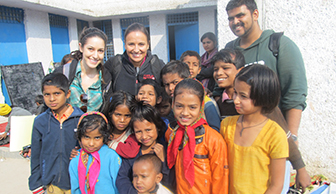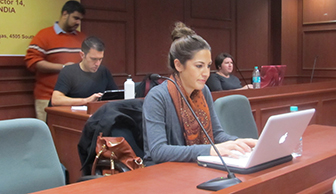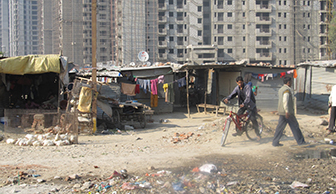Boyd Students Engage in Human Rights Work in India over Holiday Break

This year’s program focused on labor and migration issues. The students built on a project started by law students at NLUD around the rights of migrant construction workers, one of the most vulnerable and exploited groups in India.
Students interviewed the workers in teams and documented violations related to nonpayment of minimum wage and overtime, child labor, health and safety issues, and gender discrimination.
When hundreds of workers at one of the construction sites went on strike to protest the labor violations (they were working 12 hour days, 7 days a week for less than 50 cents per day), the students filed a formal complaint with the Labor Commissioner. They also submitted complaints to the National Commission for the Protection of Child Rights and the National Commission on Women’s Rights.
Before the U.S. students left India, the employer informally agreed to pay two years of back-pay to the workers; but the challenge will be following up to ensure this happens.
The three Boyd students who participated in the program -- Richard Andrews, Marisa Rodriguez-Shapoval, and Morgan Petrelli -- are currently drafting a human rights report that will synthesize the interviews, explain the violations, analyze the legal issues, and make specific recommendations. The report will include photographs documenting the violations.
The experience was a unique one for Andrews, who said that the work was incredibly compelling for him.
“The work was really substantial,” he said. “We went into the Indian labor laws and went to a construction site to make sure the law was being implemented. It turns out that it wasn’t.”
Third-year student Petrelli said it was an experience well worth the time.

“It was a lot more work than what I anticipated, but the work was good and there was a lot more hands-on experience than I had anticipated, which I liked,” Petrelli said.
The actual classes, Rodriguez-Shapoval said, provided a great opportunity to learn.
“As students, we learned on so many levels,” she said. “We had great speakers, activists, judges and professors, all in the field of human rights.”
However, she added, that classwork was only part of the process. Doing the actual field work was her favorite part of the program.
“We basically got to see how the laws are violated, so we got to see so many layers to the process, which was really interesting,” she said.
Andrews said that the practice of actually implementing the constitutional policies was a major point of difference that he found in the Indian system. He said that the way laws were or were not implemented made him wonder how the system in the U.S. worked in more specific terms.
“It triggers the questions in your mind. In terms of practical skills, asking questions is the biggest thing gained [from the program],” he said.
Rodriguez-Shapoval also noted how the laws in India, if implemented properly, would have a huge impact on how conditions are in the country.
“India probably has more progressive employment and labor laws [than the U.S.], but they’re not implemented,” she said. “I think here in the U.S., we have the mechanisms in place to implement the laws and if they’re violated, we have a system to report it. However, in India, there’s a lot of corruption, so the people who are supposed to benefit don’t even know they have these rights and don’t report violations.”
Nine Americans, three from Boyd, joined Indian students for this program. Boyd, being the school in charge of the program, was the only American university with more than one student represented.
Each group gained valuable experience from each other, Andrews said.
“For me, I learned about self-imposing break times,” he said. “All [the Indian] students were really patient, so when we [American students] were in a rush wondering when something was going to get done, they stayed relaxed and said it will get done when it gets done.”

Petrelli said that she was impressed with the passion and hard-working nature of the students she worked with.
“Most [of the Indian students] had never worked with Americans before, so it was really great that we got to work with each other,” she said.
Andrews said that the Indian students were younger, so the American law students were able to help through life experience and providing the perspective of another country’s system.
“They were most interested in learning about the American Electoral College system,” he said, “and the American legal system, and how the federal government and state government operate independently.”
Doing field work required the ability to speak in the local dialects, which fell on the local students more than the Americans.
“It was great to have an Indian student to interpret for us,” Rodriguez-Shapoval said, adding that being able to talk a lot with the Indian students on the drives to the various sites really helped to ease the transition of working in another country. "I found working with Indian students extremely easy because we had a lot of time to get to know each other. Our experience would not have been the same without them."
Petrelli said that going to India in this program would probably be a better experience than simply being a tourist.
“Going as a tourist would be difficult because you don’t know the languages, so it would be harder to get around,” she said.
Boyd professor Fatma Marouf served as director for the program this year.